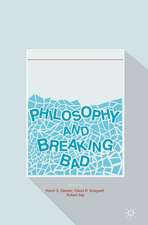Hesitant Histories on the Romanian Screen
Autor László Strauszen Limba Engleză Hardback – 7 aug 2017
This book argues that hesitation as an artistic and spectatorial strategy connects various screen media texts produced in post-war Romania. The chapters draw a historical connection between films made during the state socialist decades, televised broadcasts of the 1989 Romanian revolution, and films of the new Romanian cinema. The book explores how the critical attitude of new Romanian cinema demonstrates a refusal to accept limiting, binary discourses rooted in Cold War narratives. Strausz argues that hesitation becomes an attempt to overcome restrictive populist narratives of the past and present day. By employing a performative and mobile position, audiences are encouraged to consider conflicting approaches to history and social transformation.
| Toate formatele și edițiile | Preț | Express |
|---|---|---|
| Paperback (1) | 412.68 lei 38-44 zile | |
| Springer International Publishing – 3 aug 2018 | 412.68 lei 38-44 zile | |
| Hardback (1) | 646.43 lei 6-8 săpt. | |
| Springer International Publishing – 7 aug 2017 | 646.43 lei 6-8 săpt. |
Preț: 646.43 lei
Preț vechi: 760.50 lei
-15% Nou
Puncte Express: 970
Preț estimativ în valută:
123.69€ • 129.49$ • 102.35£
123.69€ • 129.49$ • 102.35£
Carte tipărită la comandă
Livrare economică 05-19 aprilie
Preluare comenzi: 021 569.72.76
Specificații
ISBN-13: 9783319552712
ISBN-10: 3319552716
Pagini: 256
Ilustrații: VIII, 257 p. 20 illus., 18 illus. in color.
Dimensiuni: 148 x 210 mm
Greutate: 0.59 kg
Ediția:1st ed. 2017
Editura: Springer International Publishing
Colecția Palgrave Macmillan
Locul publicării:Cham, Switzerland
ISBN-10: 3319552716
Pagini: 256
Ilustrații: VIII, 257 p. 20 illus., 18 illus. in color.
Dimensiuni: 148 x 210 mm
Greutate: 0.59 kg
Ediția:1st ed. 2017
Editura: Springer International Publishing
Colecția Palgrave Macmillan
Locul publicării:Cham, Switzerland
Cuprins
1. Introduction.- 2. Hesitation as an interpretive strategy.- 3. Modernism under construction: films on filmmaking in the Ceaușescu years.- 4. Television as a factory of history: the broadcast of the 1989 Romanian Revolution.- 5. Contesting the canon of the past: state socialism and the regime change in the new Romanian cinema.- 6. Outcasts, fugitives and migrants: mobility and social production of space.- 7. Sanatorium Romania: regulating the body in the hospital, the prison and the convent.- 8. The crisis of masculinity in post-socialist society.- 9. Epilogue: authorial films and genres, festivals and audiences.
Notă biografică
László Strausz is Assistant Professor in the Department of Film Studies at Eötvös Loránd University, Hungary.
Textul de pe ultima copertă
This book argues that hesitation as an artistic and spectatorial strategy connects various screen media texts produced in post-war Romania. The chapters draw a historical connection between films made during the state socialist decades, televised broadcasts of the 1989 Romanian revolution, and films of the new Romanian cinema. The book explores how the critical attitude of new Romanian cinema demonstrates a refusal to accept limiting, binary discourses rooted in Cold War narratives. Strausz argues that hesitation becomes an attempt to overcome restrictive populist narratives of the past and present day. By employing a performative and mobile position, audiences are encouraged to consider conflicting approaches to history and social transformation.
Caracteristici
Investigates hesitancy as a specific artistic strategy in the films of the new Romanian cinema and its antecedents Interprets the representations of history and social change in the films of the new Romanian cinema as a cultural response to the unsettling power of the images witnessed during the days of the revolution Progresses as a cultural history that isolates hesitation as the common artistic strategy of the new Romanian cinema, and explains its emergence through the social-historical context that gave birth to it Establishes connections with cinematic and televisual antecedents and thereby places the films in a wider cultural landscape




